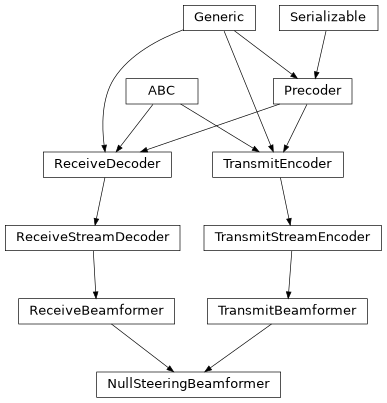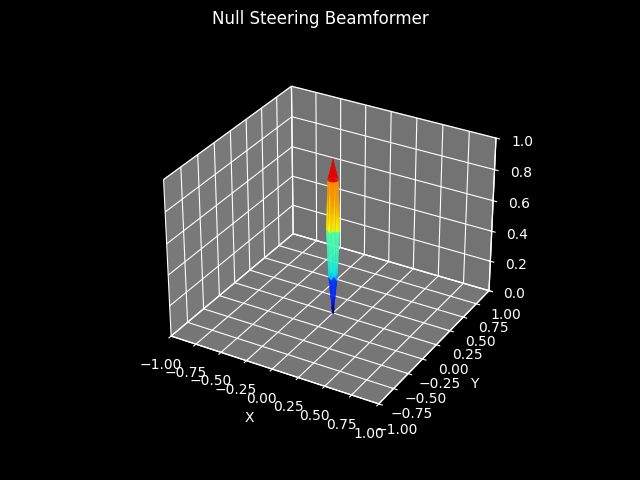Null Steering Beamformer¶

Null-steering [1] transmit beamformers aim to maximize the received signal power in the direction of the intended receiver while substantially reducing the power impinging on the unintended receivers located in other directions.
Let us introduce
and
Where \(\mathbf{a}_{\psi_{\bullet}}\) is the array propagation matrix and the vector \(W\) corresponds to the beamforming weights. Let
where \(A\) is the matrix that contains the array propagation vectors of all AoAs and \(P_T\) denote the maximum admissible total transmission power. The beamformer has maximized power in the intended direction and nulls at the unintended directions when:
The optimal solution to the above expression can be derived as:
where
is the orthogonal projection matrix onto the subspace spanned by the columns of \(A\). As such, \(W_{\text{ns}}\) is in fact the orthogonal projection of onto the null space of \(a_0\). Thus, \(W_{\text{ns}}\) is the null steering beamformer.
The radiation pattern of a NullSteeringBeamformer can be visualised using the following code snippet. A uniform array is ctreated and the NullSteeringBeamformer is assigned to the array. The radiation pattern can be visualised by specifiying the beamformer’s transmitting focus point and calling the plot_pattern method.
1# Configure a uniform antenna array
2from hermespy.simulation import SimulatedIdealAntenna, SimulatedUniformArray
3
4uniform_array = SimulatedUniformArray(SimulatedIdealAntenna, half_wavelength, (8, 8, 1))
5
6# Configure beamformer
7from hermespy.beamforming.nullsteeringbeamformer import NullSteeringBeamformer
8from hermespy.beamforming import SphericalFocus
9
10beamformer = NullSteeringBeamformer()
11beamformer.transmit_focus = [SphericalFocus(0,0),SphericalFocus(-.5*pi,.25*pi),SphericalFocus(.5*pi,.25*pi)]
12
13# Render the beamformer's characteristics
14import matplotlib.pyplot as plt
15
16_ = uniform_array.plot_pattern(carrier_frequency, beamformer, title="Null Steering Beamformer")
17plt.show()

The following section provides an example for the usage of the nullsteeringbeamformer in a communication scenario.
For this a new simulation environment is initialised. A digital antenna array consisting of ideal isotropic antenna elements spaced at half wavelength intervals is created and is assigned to a device representing a base station.
1# Initialize a new simulation
2from hermespy.simulation import Simulation
3simulation = Simulation(seed=42)
4
5# Create a new device and assign it the antenna array
6from hermespy.simulation import SimulatedUniformArray, SimulatedIdealAntenna
7from hermespy.core import Transformation
8import numpy as np
9
10base_station_device = simulation.new_device(
11 antennas=SimulatedUniformArray(SimulatedIdealAntenna, .5 * wavelength, (5, 5, 1)),
12 carrier_frequency=carrier_frequency,
13 pose=Transformation.From_Translation(np.array([0, 0, 0])),
14)
To probe the characterestics a cosine waveform is generated as the transmit waveform.
1# Configure a probing signal to be transmitted from the base station
2from hermespy.modem import RootRaisedCosineWaveform, SingleCarrierLeastSquaresChannelEstimation, SingleCarrierZeroForcingChannelEqualization, SingleCarrierCorrelationSynchronization
3
4waveform = RootRaisedCosineWaveform(
5 symbol_rate=sampling_rate//2,
6 oversampling_factor=2,
7 num_preamble_symbols=32,
8 num_data_symbols=128,
9 roll_off=.9,
10)
11waveform.synchronization = SingleCarrierCorrelationSynchronization()
12waveform.channel_estimation = SingleCarrierLeastSquaresChannelEstimation()
13waveform.channel_equalization = SingleCarrierZeroForcingChannelEqualization()
The base station device is configured to transmit the beamformed signal by assigning the NullSteeringBeamformer to the base station device.
1# Configure the base station device to transmit the beamformed probing signal
2from hermespy.beamforming import NullSteeringBeamformer
3from hermespy.modem import TransmittingModem
4from copy import deepcopy
5
6beamformer = NullSteeringBeamformer()
7base_station_device.transmit_coding[0] = beamformer
8
9base_station_transmitter = TransmittingModem(waveform=deepcopy(waveform))
10base_station_device.add_dsp(base_station_transmitter)
Now the simulation can be extended to evalaute the performance in a real world communication scenario. For this three devices representing the UEs are added, to be illuminated by the BS.
1# Create three simulated devices representing the user equipments (Since nullsteeringbeamformer has 3 focus points)
2user_equipment_device_1 = simulation.new_device(
3 carrier_frequency=carrier_frequency,
4 pose=Transformation.From_Translation(np.array([200., 200., 100.])),
5)
6user_equipment_device_2 = simulation.new_device(
7 carrier_frequency=carrier_frequency,
8 pose=Transformation.From_Translation(np.array([200., -200., 100.])),
9)
10user_equipment_device_3 = simulation.new_device(
11 carrier_frequency=carrier_frequency,
12 pose=Transformation.From_Translation(np.array([-400., 200., 100.])),
13)
14
The user equipments can be configured to receive the signal by setting them up as receiving modems.
1# Configure the user equipments to receive the signal
2from hermespy.modem import ReceivingModem
3
4ue_receiver_1 = ReceivingModem(waveform=deepcopy(waveform))
5ue_receiver_2 = ReceivingModem(waveform=deepcopy(waveform))
6ue_receiver_3 = ReceivingModem(waveform=deepcopy(waveform))
7user_equipment_device_1.add_dsp(ue_receiver_1)
8user_equipment_device_2.add_dsp(ue_receiver_2)
9user_equipment_device_3.add_dsp(ue_receiver_3)
10
Now as defined the nullsteeringbeamformer illuminates the maximum radiation on one UE whereas the nulls on the others. This can be realised by configuring the transmit foucs of the Beamformer.
1# Focus the base station's main lobe on the desired user equipment and nulls on the others
2from hermespy.simulation import DeviceFocus
3
4beamformer.transmit_focus = [
5 DeviceFocus(user_equipment_device_1), # Focus on UE1
6 DeviceFocus(user_equipment_device_2), # Null on UE2
7 DeviceFocus(user_equipment_device_3), # Null on UE3
8]
9
The propgation characterestics between the BS and the UEs can be modelled using the SpatialDelayChannel Model.
1# Configure a channel between base station and the UEs
2from hermespy.channel import SpatialDelayChannel
3
4simulation.set_channel(
5 base_station_device,
6 user_equipment_device_1,
7 SpatialDelayChannel(model_propagation_loss=False),
8)
9
10simulation.set_channel(
11 base_station_device,
12 user_equipment_device_2,
13 SpatialDelayChannel(model_propagation_loss=False),
14)
15
16simulation.set_channel(
17 base_station_device,
18 user_equipment_device_3,
19 SpatialDelayChannel(model_propagation_loss=False),
20)
Now hermespy can be instructed to conduct a simulation campaign to evaluate the received signal power at the UEs by adding the evaluator.
1# Run the simulation and analyze the power received by the 3 UEs by adding an evaluator.
2from hermespy.core import ReceivePowerEvaluator
3
4simulation.add_evaluator(ReceivePowerEvaluator(ue_receiver_1))
5simulation.add_evaluator(ReceivePowerEvaluator(ue_receiver_2))
6simulation.add_evaluator(ReceivePowerEvaluator(ue_receiver_3))
7
8# Creating a new dimension to dynamically switch the focus of the beamformer during the simulation campaign.
9simulation.new_dimension(
10 'transmit_focus',
11 [
12 [DeviceFocus(user_equipment_device_1), DeviceFocus(user_equipment_device_2), DeviceFocus(user_equipment_device_3)],
13 [DeviceFocus(user_equipment_device_2), DeviceFocus(user_equipment_device_3), DeviceFocus(user_equipment_device_1)],
14 [DeviceFocus(user_equipment_device_3), DeviceFocus(user_equipment_device_1), DeviceFocus(user_equipment_device_2)],
15 ],
16 beamformer
17)
18result = simulation.run()
In the previous example the NullSteeringBeamformer was assigned to transmitting base station. The same example can be adpated to study the performance of the beamformer assigned to a receiving base station.
The base station is configured for reception.
1# Configure the base station device to receive the probing signal
2from hermespy.beamforming import NullSteeringBeamformer
3from hermespy.modem import ReceivingModem
4from copy import deepcopy
5
6beamformer = NullSteeringBeamformer()
7base_station_device.receive_coding[0] = beamformer
8
9base_station_receiver = ReceivingModem(waveform=deepcopy(waveform))
10base_station_device.add_dsp(base_station_receiver)
The UEs will be configured as transmitting.
1# Configure the user equipments to transmit the signal
2from hermespy.modem import TransmittingModem
3
4user_equipment_transmitter_1 = TransmittingModem(waveform=deepcopy(waveform))
5user_equipment_transmitter_2 = TransmittingModem(waveform=deepcopy(waveform))
6user_equipment_transmitter_3 = TransmittingModem(waveform=deepcopy(waveform))
7user_equipment_device_1.add_dsp(user_equipment_transmitter_1)
8user_equipment_device_2.add_dsp(user_equipment_transmitter_2)
9user_equipment_device_3.add_dsp(user_equipment_transmitter_3)
The receieve focus of the beamformer will be configured.
1# Focus the base station's main lobe on the desired user equipment and nulls on the others.
2from hermespy.simulation import DeviceFocus
3
4beamformer.receive_focus = [
5 DeviceFocus(user_equipment_device_1), # Focus on User Equipmment 1
6 DeviceFocus(user_equipment_device_2), # Null on User Equipmment 2
7 DeviceFocus(user_equipment_device_3), # Null on User Equipmment 3
8]
The performance of the beamformer is studied by analysing the received signal quality from the respective UEs. For this purpose, the Error Vector Magnitude of the consetallation diagram of the Received signal is evaluated.
1# Run the simulation and analyze the constellation diagram of the received signal from the UEs.
2from hermespy.modem import ConstellationEVM
3
4simulation.add_evaluator(ConstellationEVM(user_equipment_transmitter_1, base_station_receiver))
5simulation.add_evaluator(ConstellationEVM(user_equipment_transmitter_2, base_station_receiver))
6simulation.add_evaluator(ConstellationEVM(user_equipment_transmitter_3, base_station_receiver))
7
8# Creating a new dimension to dynamically switch the focus of the beamformer during the simulation campaign.
9simulation.new_dimension(
10 'receive_focus',
11 [
12 [DeviceFocus(user_equipment_device_1), DeviceFocus(user_equipment_device_2), DeviceFocus(user_equipment_device_3)],
13 [DeviceFocus(user_equipment_device_2), DeviceFocus(user_equipment_device_3), DeviceFocus(user_equipment_device_1)],
14 [DeviceFocus(user_equipment_device_3), DeviceFocus(user_equipment_device_1), DeviceFocus(user_equipment_device_2)],
15 ],
16 beamformer
17)
18result = simulation.run()
- class NullSteeringBeamformer[source]¶
Bases:
TransmitBeamformer,ReceiveBeamformer- _decode(samples, carrier_frequency, angles, array)[source]¶
Decode signal streams for receive beamforming.
This method is called as a subroutine during
decode_streamsandprobe.- Parameters:
samples (
ndarray) – Signal samples, first dimension being the number of signal streams \(N\), second the number of samples \(T\).carrier_frequency (
float) – The assumed carrier central frequency of the samples \(f_\mathrm{c}\).angles (
ndarray) – Spherical coordinate system angles of arrival in radians. A three-dimensional numpy array with the first dimension representing the number of angles, the second dimension of magnitude number of focus points \(F\), and the third dimension containing the azimuth and zenith angle in radians, respectively.array (
AntennaArrayState) – The assumed antenna array.
- Return type:
- Returns:
Stream samples of the focused signal towards all focus points. A three-dimensional numpy array with the first dimension representing the number of focus points, the second dimension the number of returned streams and the third dimension the amount of samples.
- _encode(samples, carrier_frequency, focus_angles, array)[source]¶
Encode signal streams for transmit beamforming.
- Parameters:
samples (
ndarray) – Signal samples, first dimension being the number of transmit antennas, second the number of samples.carrier_frequency (
float) – The assumed central carrier frequency of the samples generated RF signal after mixing in Hz.focus_angles (
ndarray) – Focused angles of departure in radians. Two-dimensional numpy array with the first dimension representing the number of focus points and the second dimension of magnitude two being the azimuth and elevation angles, respectively.array (
AntennaArrayState) – The assumed antenna array.
- Return type:
- Returns:
The encoded signal samples. Two-dimensional complex-valued numpy array with the first dimension representing the number of transmit antennas streams and the second dimension the number of samples.
- num_receive_output_streams(num_input_streams)[source]¶
Get required number of output streams during decoding.
Returns: The number of output streams. Negative numbers indicate infeasible configurations.
- num_transmit_input_streams(num_output_streams)[source]¶
Get required number of input streams during encoding.
Returns: The number of input streams. Negative numbers indicate infeasible configurations.
- property num_receive_focus_points: int¶
Number of required receive focus points.
If this is \(1\), the beamformer is considered to be a single focus point beamformer and
receive_focuswill return a single focus point. Otherwise, the beamformer is considered a multi focus point beamformer andreceive_focuswill return aSequenceof focus points.Returns: Number of focus points.
- property num_transmit_focus_points: int¶
Number of required transmit focus points.
If this is \(1\), the beamformer is considered to be a single focus point beamformer and
transmit_focuswill return a single focus point. Otherwise, the beamformer is considered a multi focus point beamformer andtransmit_focuswill return aSequenceof focus points.